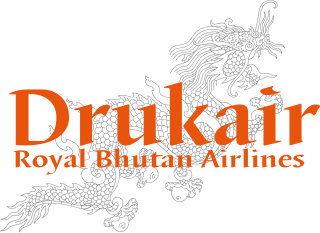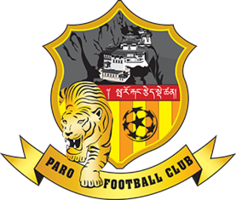
Haa District is one of the 20 dzongkhag or districts comprising Bhutan. Per the 2017 census, the population of Haa dzongkhag was 13,655 in 2,952 households making it the second least populated dzongkhag in Bhutan after Gasa. The dominant language of the district is Dzongkha, the national language.

Paro District is a district (dzongkhag), valley, river and town in Bhutan. It is one of the most historic valleys in Bhutan. Both trade goods and invading Tibetans came over the pass at the head of the valley, giving Paro the closest cultural connection with Tibet of any Bhutanese district. The dominant language in Paro is Dzongkha, the national language.

Drukair Corporation Limited, operating as Drukair — Royal Bhutan Airlines, is the flag carrier of the Kingdom of Bhutan, headquartered in the western dzongkhag of Paro.

Paro International Airport is the sole international airport of the four airports in Bhutan. It is 6 km from Paro in a deep valley on the bank of the river Paro Chhu. With surrounding peaks as high as 5,500 m (18,000 ft), it is considered one of the world's most challenging airports, and fewer than two dozen pilots are certified to land at the airport.

Paro is a town and seat of Paro District, in the Paro Valley of Bhutan. It is a historic town with many sacred sites and historical buildings scattered throughout the area. It is also home to Paro Airport, Bhutan's sole international airport.

Dokar Gewog is a gewog of Paro District, Bhutan. In 2002, the gewog had an area of 106.1 square kilometres and contained 21 villages and 327 households.

Dopshari Gewog is a gewog of Paro District, Bhutan. In 2002, the gewog had an area of 36.7 square kilometres and contained 24 villages and 299 households.

Doteng Gewog is a gewog of Paro District, Bhutan. In 2002, the gewog had an area of 193.1 square kilometres and contained eight villages and 143 households.

Hungrel Gewog is a gewog of Paro District, Bhutan. In 2002, the gewog had an area of 3.6 square kilometres and contained 17 villages and 247 households.

Lamgong Gewog is a gewog of Paro District, Bhutan. The gewog had an area of 48.8 square kilometres in 2002, and contained eight villages and 348 households.

Lungnyi Gewog is a gewog of Paro District, Bhutan. In 2002, the gewog had an area of 59.7 square kilometres and contained seven villages and 265 households.

Naja Gewog is a gewog of Paro District, Bhutan. In 2002, the gewog had an area of 151.8 square kilometres and contained 13 villages and 355 households.

Shapa Gewog is a gewog of Paro District, Bhutan. In 2002, the gewog had an area of 76.4 square kilometres and contained 8 chewogs and 253 households.

Tsento Gewog is a gewog of Paro District, Bhutan. In 2002, the gewog had an area of 575.1 square kilometres and contained 14 villages and 332 households. The border can be accessed through a secret road/trail connecting Phari in China known as Tremo La.

Wangchang Gewog is a gewog of Paro District, Bhutan. In 2002, the gewog had an area of 34.2 square kilometres and contained 7 chewogs and 278 households.

Paro Province was one of the nine historical Provinces of Bhutan.

Paro FC is a Bhutanese professional football club based in Paro that competes in the Bhutan Super League and Bhutan Premier League, the top flights of Bhutanese football.
The production of Bhutan wine is reported to have first been attempted in the 1990s, with the introduction of an experimental vineyard at Paro near Thimpu, the capital of Bhutan. Australian wine company, Taltarni, is believed to have provided technical help, but it is not known whether any wine was successfully produced.
The 2018 Bhutan National League was the seventh season of the Bhutan National League, the national football competition in Bhutan, having replaced the A-Division in 2013. Again, the Thimphu League provides the qualifiers from Thimphu, with the top three teams in that competition being awarded places in the National League alongside three regional teams.









